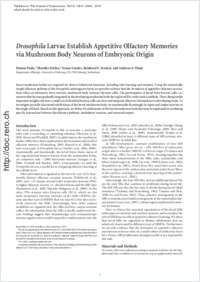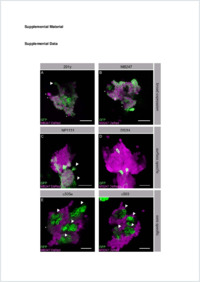Drosophila larvae establish appetitive olfactory memories via mushroom body neurons of embryonic origin
- Pauls, Dennis Department of Biology, University of Fribourg, Switzerland
- Selcho, Mareike Department of Biology, University of Fribourg, Switzerland
- Gendre, Nanaë Department of Biology, University of Fribourg, Switzerland
- Stocker, Reinhard F. Department of Biology, University of Fribourg, Switzerland
- Thum, Andreas S. Department of Biology, University of Fribourg, Switzerland
-
11.08.2010
Published in:
- The Journal of Neuroscience. - 2010, vol. 30, no. 32, p. 10655-10666
English
Insect mushroom bodies are required for diverse behavioral functions, including odor learning and memory. Using the numerically simple olfactory pathway of the Drosophila melanogaster larva, we provide evidence that the formation of appetitive olfactory associations relies on embryonic-born intrinsic mushroom body neurons (Kenyon cells). The participation of larval-born Kenyon cells, i.e., neurons that become gradually integrated in the developing mushroom body during larval life, in this task is unlikely. These data provide important insights into how a small set of identified Kenyon cells can store and integrate olfactory information in a developing brain. To investigate possible functional subdivisions of the larval mushroom body, we anatomically disentangle its input and output neurons at the single-cell level. Based on this approach, we define 10 subdomains of the larval mushroom body that may be implicated in mediating specific interactions between the olfactory pathway, modulatory neurons, and neuronal output.
- Faculty
- Faculté des sciences et de médecine
- Department
- Département de Biologie
- Language
-
- English
- Classification
- Biological sciences
- License
- License undefined
- Identifiers
-
- RERO DOC 20539
- DOI 10.1523/JNEUROSCI.1281-10.2010
- Persistent URL
- https://folia.unifr.ch/unifr/documents/301612
Other files
Statistics
Document views: 113
File downloads:
- sto_dle.pdf: 174
- sto_dle_sm.pdf: 117

